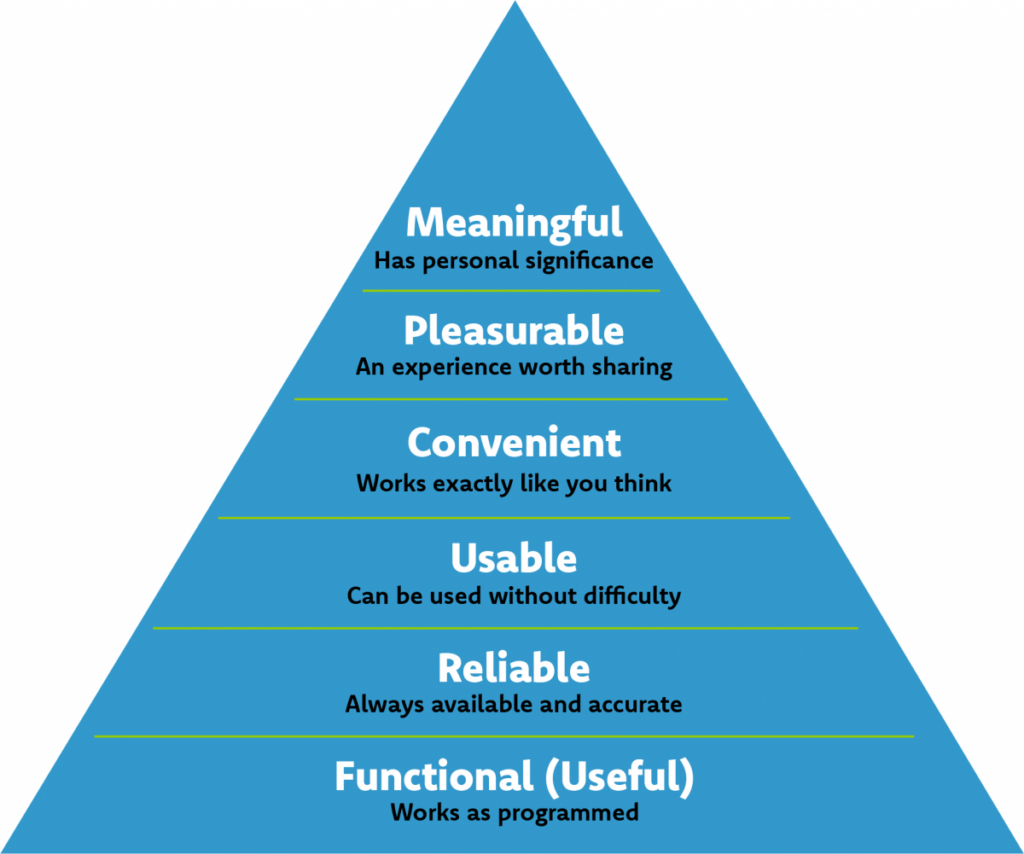Monetize your digital ecosystem through great user experiences.
There’s an “experience gap” in websites today. It spans B2B and B2C markets. We see it in customer satisfaction research. We even experience it as consumers. We expect more from online experiences than we typically get.

To illustrate the experience gap, experience strategist Hertje Brodersen created a UX hierarchy based on Abraham Maslow’s hierarchy of needs.
Users expect ease, speed and personalization. And every interaction counts. According to PWC research, one in three consumers will leave a brand they love after just one bad experience. Eighty-six percent of consumers will pay more for a good experience. Companies that prioritize customer experiences net a 16% price premium on average.
UX is the success driver. It builds brand equity, customer loyalty and financial growth. Great user experiences turn your prospects into customers and your customers into vocal brand champions.
The Financial Impact of UX
We believe UX research, strategy and testing enhance digital performance and grow business outcomes. A well-executed UX strategy increases sales, lowers the costs of customer acquisition and increases customer retention.
The financial impact is significant. Forrester estimates that every dollar spent on UX yields $100 in return. UX also dramatically reduces enterprise digital costs in design, development and maintenance.
UX can even be the starting point for organizational evolution. It can help advance the cultural and operational shifts necessary to create customer-centric differentiation across an entire enterprise.
We work with your teams to create a UX strategy centered on real-life user needs. We can also help operationalize UX. By sharing user insights across functions, you can ensure a great experience at every touchpoint.
The User Experience Audit
To lay the groundwork for UX strategy, we often conduct a UX audit. We start by analyzing user behaviors, site functionality and overall website performance. This UX review yields quick wins for common client problems such as underperforming landing pages, negative user feedback and other usability issues. Its concentrated focus allows us to deliver actionable recommendations quickly and efficiently.
For website redesigns, we go deeper. We create an inventory of the digital content within a website or digital ecosystem. Then we pair the inventory with data from Google Analytics and other sources.
Performance metrics such as traffic and revenue tell only half the story. We also analyze metrics that signal UX success (and usability problems). Called the Google HEART framework, these include happiness, engagement, adoption, retention and task completion.
To get a holistic view of the ecosystem, we also evaluate:
- User flows
- Information architecture
- Visual design
- On-site search
- Page load speeds
- Accessibility
- Technical SEO
This not only helps us identify usability issues. It also helps us identify opportunities for acquisition, retention and monetization within each environment.
When combined with user research and usability tests, our UX audit report gives us a 360-degree view into your digital ecosystem. It’s the perfect vantage in which to set meaningful goals, prioritize efforts and create measurable growth.
Start Your UX Audit
Every touchpoint shapes your user’s experience. Every touchpoint should drive business value. Our UX strategy ensures that these touchpoints work together to delight users and fuel business growth.
Our UX audits are the foundation of our UX strategy. We tailor each audit to the client’s needs and digital properties. These can include websites, intranets, paid media campaigns and even enterprise digital ecosystems.
Get in touch with us to explore how a UX audit can help you monetize your digital ecosystem through great user experiences.

